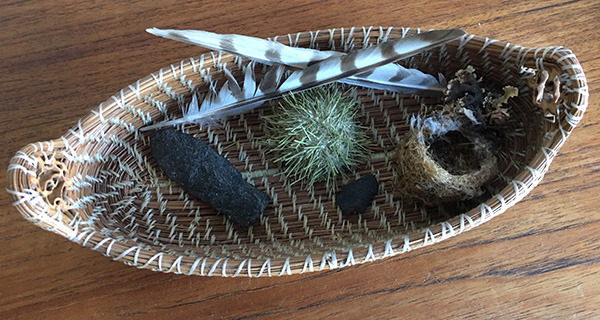
A Skelhp basket with a rufous hummingbird nest in the right hand corner. The signs of spring are everywhere. Photo by Michael Robinson
 My British Museum 2019 Diary proclaims the vernal equinox arrived on March 20 this year, with a cryptic little note: “Spring begins.” At Skelhp, we already knew.
My British Museum 2019 Diary proclaims the vernal equinox arrived on March 20 this year, with a cryptic little note: “Spring begins.” At Skelhp, we already knew.
In fact, I think spring began on Sunday, March 10, when we descended artfully on the deer-fenced garden with pruning clippers to shape some apple and cherry trees.
Long ago, a biologist friend of mine told me to prune my fruit trees with the shape of a tea cup in mind. The idea is to leave a circular rim of outer branches with a hollow core so the sun’s rays can reach the inside of the foliage.
As I clipped, the sun was shining, and the grey gloom of February was rapidly being replaced with drier air and some familiar buzzes, croaks and tweets.
We first noticed the yellow-faced bumble bees. They were crawling over the heather in the rhododendron garden, and swarmed around the barbecue when outdoor cooking replaced grilling and baking inside.
No one has been stung yet. The bees aren’t aggressive, but they are interested in barbecuing wild sockeye steaks and Lois Lake steelhead, “cooked to the fire,” as they say in the western Arctic.
Next it was the evening chorus of bullfrogs, Pacific tree frogs and western toads. Their jug-o-rums, kree-eeks, and peeps are all audible now after dark. All you have to do is open the front door and go out on the porch. On quiet nights, you can just hear them inside the house. They’re definitely the welcoming symphony of spring.

The ‘whump’-proofed window in shower deck door, to keep robins from attempting to fly through the glass. Photo by Michael Robinson
On March 24, right on time, our Mexican neighbours arrived just as the arbutus trees slowly began to bloom. Down the beach in the prophetically named Hummingbird Cove, the first settlers in this part of the world in the early 1900s noted the arrival (and all subsequent re-arrivals) of the first rufous hummingbird on March 14.
After flying over 6,000 kilometres from southern Mexico to Skelhp, in a few short months, it apparently takes them an extra 10 days to reach our garden, some two kilometres west of Hummingbird Cove. Many quickly make their tiny nests and lay their eggs so the fledglings are able to fly down to Mexico at summer’s end.
Next, predictably in the spring cavalcade, are the early-morning “whumps.”
Picture lying in bed on Saturday morning and suddenly becoming aware of “whump, whump, whump” somewhere outside against the house.
My wife woke up last weekend and said, “Michael, there’s a woodpecker outside pecking on the siding.”
I listened carefully and respectfully disagreed. “No, it’s not rat-a-tat-tatting enough. It’s a bloody robin trying to fly through the window in the bathroom door to nest!”
We have an outdoor shower and, predictably, right after the hummers arrive to nest, the robins begin their routine of trying to nest inside our house. One year, a poor bird smashed repeatedly into the door’s window while we were away and we found it covered in its own blood, dead on the shower deck.
This year, I sprang into action with tape and the Sports section of the Globe and Mail. Three sheets of paper covered the entire window and almost immediately the whumping stopped. I’m standing by with the Business section just in case the robin chooses another window.
A new phenomenon noticed this spring was a nightly cat-like cry. It’s stopped now but was audible from mid-March, when I heard it walking home from a neighbourly dinner. At first, my senses sharpened because it reminded me somewhat of a cougar’s cry. But it was too low and seemed to be coming from up in a spruce tree.
I puzzled over the source of the cry and luckily received a call from my pal Elmer the next day. He grew up Metis in the bush in northern Alberta, and has a diagnostic understanding of bird and animal lore. When we talk of my newfound enthusiasm for country living, he’s always willing to ground my enthusiasms in what he terms traditional science.
“Michael, what you heard was an owl’s mating cry. They mate early so their owlets are large enough to tough out the long winters. They’re a part of your new traditional knowledge.”
It seems my spring semester is well underway.
Troy Media columnist Mike Robinson has been CEO of three Canadian NGOs: the Arctic Institute of North America, the Glenbow Museum and the Bill Reid Gallery.
The views, opinions and positions expressed by columnists and contributors are the author’s alone. They do not inherently or expressly reflect the views, opinions and/or positions of our publication.


